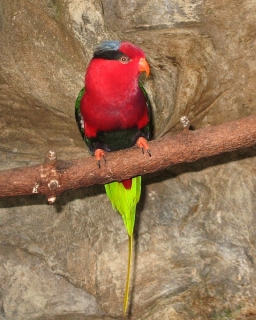Stella’s Lorikeet |
|
|
Photos
View in GalleryDid You Know?
Stella’s Lorikeet has a melanistic phase, whereby its plumage is replaced with varying light/dark black tones.
Academic Research
Related publications: Charmosyna stellaeSpecies Profile
Genus: Charmosyna | Species: stellae
Size:
25cm (9.75 in)
Weight:
90-115g (3.1-4 oz)
Subspecies including nominate:
three: C.s. stellae, C.s. goliathina, C.s. wahnesi
Colour Adult:
C.s. stellae: (Has melanistic phase, where red is replaced with black) male-black patch reaching from occiput to hindneck and streaked in front with purple/blue; black lower flanks, yellow absent; yellow on sides of breast absent; centre tail feathers elongated and widely tipped with yellow/orange. Female-as in male but lower back and sides of rump yellow.
C.s. goliathina: (Has melanistic phase) both adults as in stellae, but with long central tail feathers widely tipped with yellow.
C.s. wahnesi: (Has melanistic phase) both adults as in stellae, but with broad yellow band across upper abdomen.
Colour Juvenile:
C.s. stellae: In general duller than adults; with black margins on feathers of neck and breast; yellow underwing band in varying proportions; elongated tips to central tail feathers absent.
C.s. goliathina: As in adults.
C.s. wahnesi: As in adults.
Call:
Are described as distinctive; in flight are loud and slurred in upward inflection; also quieter, mellower screech. When feeding or at rest emits a nasal, long note increasing in volume.
More Information:
Avibase
Research: Improved systematics of lorikeets reflects their evolutionary history and frames conservation priorities
Content Sources:
BirdLife International
Cornell Lab of Ornithology/Birds of the World
Parrots in Aviculture, R. Low, 1992.
Photos
View in GalleryDid You Know?
Stella’s Lorikeet has a melanistic phase, whereby its plumage is replaced with varying light/dark black tones.
Academic Research
Related publications: Charmosyna stellaeSpecies Care
Captive Status:
Rare.
Longevity:
15+ years.
Housing:
Aviary with concrete, sloping floor towards drain, or suspended enclosure over concrete base.
Diet:
Nectar, either a commercial type or homemade from baby cereal (lactose-free), honey and malt extract or molasses, mixed with filtered water and made fresh daily; fruit (once or twice daily) such as: apple, pear, banana, orange, cactus fruits; vegetables such as: carrot, fresh corn on the cob or unsalted tinned sweet corn, green leaves such as Swiss chard, lettuce or dandelion; rearing food made from hard-boiled egg, wholegrain bread and carrot, all ground to a crumbly consistency.
Enrichment:
Avid bathers, provide water bowls or spray misters once a day; socialization; large enclosure for daily flights. Also provide swings, ladders and other toys, all easy to clean, to appeal to the acrobatic nature of this species.
Nest Box Size:
Vertical box 6" x 6" x 12" (15.2cm x 15.2cm x 30.5cm).
Clutch Size:
2
Incubation Time:
26 days or more.
Fledging Age:
About 7-8 weeks.
Hatch Weight:
4g.
Peak Weight:
Not recorded.
Weaning Weight:
Not recorded.
Photos
View in GalleryDid You Know?
Stella’s Lorikeet has a melanistic phase, whereby its plumage is replaced with varying light/dark black tones.
Academic Research
Related publications: Charmosyna stellaeSpecies Wild Status
World Population:
Not recorded.
IUCN Red List Status:
Least Concern
CITES Listing:
Appendix II (as congener of Charmosyna papou)
Threat Summary:
Reported to be fairly common but skins are greatly prized as head decorations by highland people and are often traded.
Range:
C.s. stellae: Mountains of E Papua New Guinea, west to Angabunga River and Herzog Mountains.
C.s. goliathina: Mountains of western and central New Guinea, from head of Geelvink Bay, Irian Jaya, east to C Papua New Guinea.
C.s. wahnesi: Mountains of Huon Peninsula, N Papua New Guinea.
Habitat:
Seen in montane forest up to 1800–3500m, occasionally as low as 1400m, including in disturbed Nothofagus-Podocarpus forest.
Wild Diet:
Seen feeding on blossoms, flower buds, pollen, soft fruit of Schefflera and other trees. Also recorded foraging for small seeds and insects (possibly ingested accidentally).
Ecology and Behaviour:
Usually observed singly or in pairs, and can be aggressive towards other lorikeets. Numbers appear to wax and wane with local food supply, suggesting a degree of local nomadism.
Clutch and Egg Size:
2 eggs
Breeding Season:
Young birds seen October–November.
Photos
View in GalleryDid You Know?
Stella’s Lorikeet has a melanistic phase, whereby its plumage is replaced with varying light/dark black tones.
Academic Research
Related publications: Charmosyna stellaeMembers Only Resources
Please log-in now to find more research, resources and tools.
Not a Member?
Find more great information:
Gain exclusive access to 600+ pages of additional research, seminars and podcasts, specialists to ask your toughest questions, and dozens of other fun resources - when you become a WPT member.
Join Today >>

































